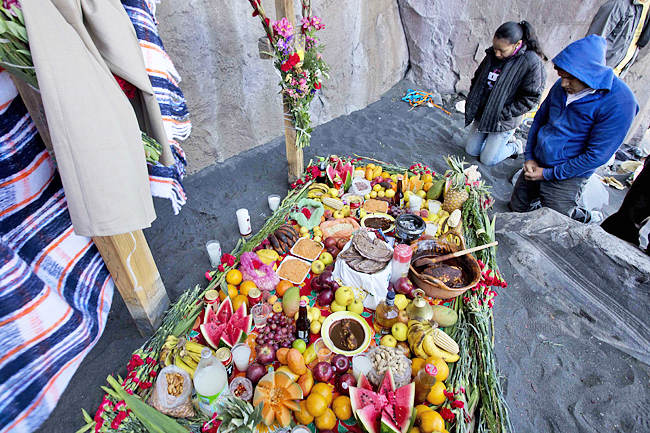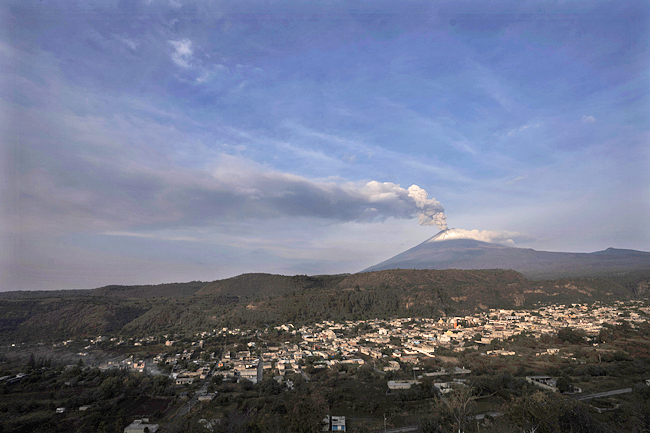Maria Teresa Hernandez
AMECAMECA, MEXICO (AP) – Moisés Vega has a distinctive job: The 64-year-old Mexican said he can speak the sacred language of volcanoes to ask for good weather and a good crop.
Mexico lowered the alert level on the Popocatépetl volcano by early June after its eruptions of gas and ash had drawn international attention. For Vega, though, the 5,425-metre mountain, known as El Popo, is a living being that never fades from his sight.
“The Popocatépetl is our father and the Iztaccíhuatl is our mother,” he said, referring to a neighbouring volcano. “They are providers of water and we are not afraid of them. On the contrary, their exhalations are blessings because they give us life.”
There is no English translation for his profession, but among the inhabitants of the towns of central Mexico, men like him are called graniceros.
“Their work is based on the pre-Hispanic notion of conciliation with nature,” said archaeologist Arturo Montero, from the University of Tepeyac.
“They are regulators of the weather who believe that the mountains are spirits of nature.”
It’s unknown how many graniceros are in Mexico. Vega said in Amecameca, the city where he lives 44 miles southeast of Mexico City, there are only four (himself included). He estimates that there could be a similar number in nearby towns.



Many locals believe that only men struck by lightning and survive – Vega among them – are the ones who can claim the job.
“I knew I would become a granicero since I was a boy,” Vega said. He was ordained to fill that role in a ritual in 1998.
His main task is to perform rituals three times per year to ask the volcanoes for good weather; just the right amount of rain needed for the crops. He mostly leads these ceremonies in stone shrines built by the locals in El Popo or El Izta.
He also works as a traditional healer and makes additional income explaining El Popo’s story to tourists visiting a volcano museum in Amecameca.
Montero said it’s not easy for contemporary graniceros to remain well-versed in ancient knowledge, given that many have to take a variety of jobs to get by. But they want to preserve their ancestral legacy and responding to inquiries from anthropologists, journalists and tourists helps them do that, he said.
On a recent Sunday, Vega pointed to a replica of a shrine built to show visitors what real temples devoted to volcanoes look like. He said the rituals he performs are a fusion of pre-Hispanic and religious elements.
The roar of El Popo tells him that something is wrong. Someone may have climbed its slopes to perform an animal sacrifice, which is against the community’s beliefs. A thief may have stolen items from their sacred spots.
The sacred understanding of El Popo varies from town to town, but many agree that the volcano does not threaten their lives. Leticia Muñoz, who sells avocados in the town of Ozumba, said she trusts graniceros more than the government and she would never evacuate her home. “One sees that (the volcano) is harmless,” she said. “If he wanted to, he would explode.”
The last big eruption of El Popo was in 1994; many in Mexico City could see the smoke.
Many people who were evacuated said they lost their animals and vowed they would never leave again.
The connection between local communities and volcanoes has evolved through the centuries because each mountain responds to the needs of its inhabitants, said anthropologist Laura Elena Romero from the University of the Americas Puebla.
According to Romero, the sacred mountains of Mesoamerica are associated with the essential resources of life and that is why graniceros like Vega make offerings to ask for rain while others request prosperity for their businesses.
During rituals, she said, there’s a dialogue between men and volcanoes and they are seen as members of each community.
“The volcano wouldn’t harm the people to whom it belongs,” she said.






